10 King Cakes From Around The World
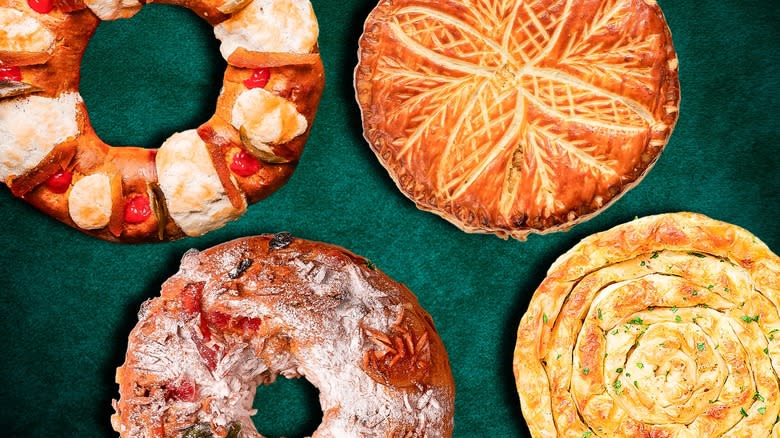
Whether or not you've shouted "Throw me somethin', mister!" at a Mardi Gras parade in Louisiana, you're probably familiar with the classic purple, green, and gold king cakes served up in The Pelican State and across the United States from early January through early spring. But did you know that king cakes are commonplace in countries around the world?
From Poland to Portugal and Germany to Greece, king cake is often associated with the Epiphany, or the Twelfth Night, when the three kings traveled to Bethlehem to present Jesus with gifts of gold, frankincense, and myrrh after his birth. In regions with Catholic traditions, in particular, king cake is enjoyed from the Epiphany on January 6 until Fat Tuesday, also known as Carnival season, the day after which the season of Lent begins — and so does the fasting that comes with it. In other parts of the world, including Bulgaria and Greece, king cake is a must-have on New Year's Eve.
Regardless of region, king cakes tend to be circular, some with a hole in the center, to symbolize a king's crown with the shape of the cake. Many king cakes are actually bread-based, relying on toppings and fillings to provide the sweetness expected from a cake. But no matter the shape or flavor, all king cakes have one purpose: To bring friends and families together in times of celebration.
Read more: 30 Types Of Cake, Explained
Saturnalia
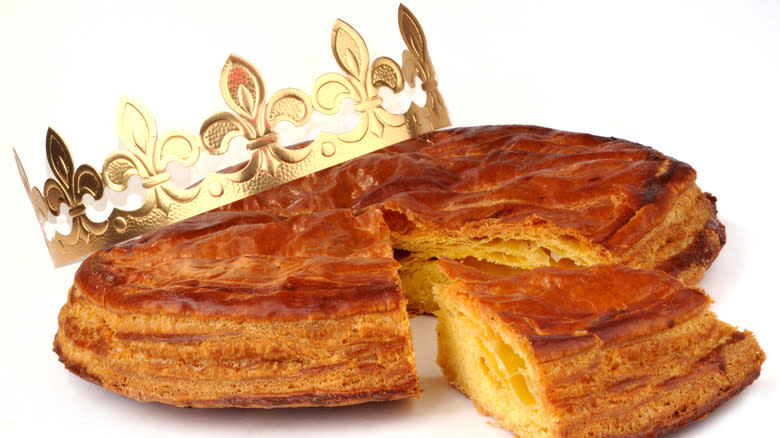
The Roman Empire's annual Saturnalia celebration is thought to be the birthplace of the king cake. Because this much-anticipated pagan festival honored the agricultural god Saturn, it is believed that a cake resembling the color and shape of the sun, similar to a French galette des rois, was served during the festivities. And, because it was held in mid-December during the winter solstice, Saturnalia was also the beginning of many of the Christmas customs observed to this day.
The weeklong Saturnalia festival was known for its raucous celebrations, complete with dancing, drinking, gambling, feasting, masquerading, and singing — not unlike modern-day Mardi Gras celebrations in New Orleans. A "king of the day" was chosen by baking a fava bean — which was believed to have magical powers — into a cake made with dried figs, dates and honey. It wasn't until the middle ages that this king cake custom was associated with the Epiphany. Since then, a bean, a baby symbolizing Jesus, a coin, or another small trinket has become synonymous with king cakes around the world, often bringing the person who finds it good luck.
Banitsa
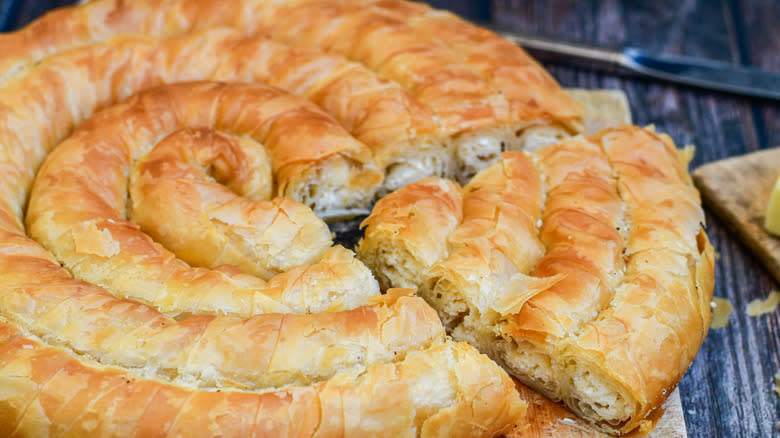
While the king cakes Americans are most familiar with are sweet, the Bulgarian equivalent, banitsa, is typically savory. Traditionally made of unleavened phyllo (or filo) dough, eggs, feta cheese, and yogurt, this buttery, flaky pastry can be enjoyed hot or cold. And although it can be found on breakfast tables and at special occasions like baptisms, festivals, and weddings year round, banitsa is the star of the show on New Year's Eve.
When ringing in a new year, it's customary to bake good luck charms right into banitsa, similar to the plastic baby commonly found in American king cakes. Unlike the singular plastic baby in American king cakes, there are plenty of special ingredients to go around in New Year's banitsas. These add-ins often have fortune-telling abilities, from hand-written notes with predictions for the coming year to budding dogwood branches with blooms that represent different fortunes about health, love, and more.
As a symbol of the rebirth and renewal often associated with the beginning of a new year, dogwood is the perfect accompaniment to a celebratory dish like banitsa. Some Bulgarian traditions suggest that when thrown into a fire after a banitsa has been enjoyed, dogwood branches that pop while burning bring extra good luck.
Bolo-rei
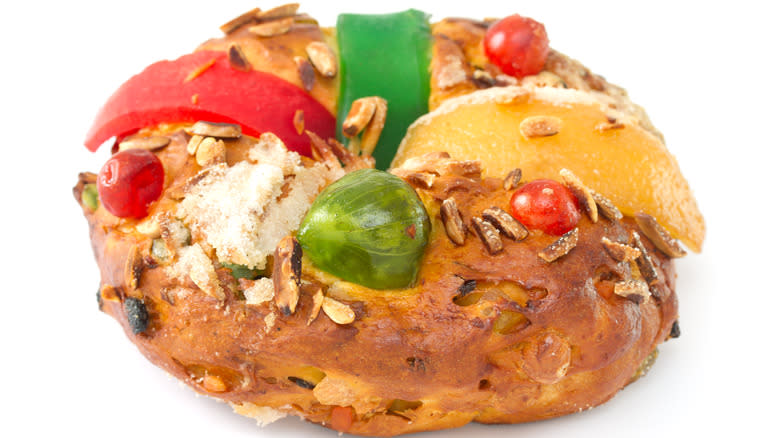
Like its American counterpart, Portuguese king cake bolo-rei originated in France. Since arriving in Lisbon from Toulouse in the late 1800s, bolo-rei, which means "king cake" in Portuguese, has ascended the throne to become holiday royalty. Bolo-rei is synonymous with the Christmas season and is especially popular on the Epiphany on January 6, or Dia de Reis (Kings' Day) as it's known in Portugal, when it's baked with a nougat crown for the occasion. Each element of bolo-rei represents the gifts each of the three kings, or three wise men, gave to Jesus after his birth: the crust symbolizes gold, the aroma symbolizes frankincense, and the fruits and nuts symbolize myrrh.
Bursting with bright greens, reds, and yellows, bolo-rei is a cornucopia of flavors, including cherry, fig, lemon, orange, pumpkin, and tangerine. Baked into a ring shape, brioche-like bolo-rei is then topped with a garnish of candied fruits and nuts like almonds, pine nuts, raisins, and walnuts. It's often adorned with the rinds of the citrus fruits contained within, as well, with a bean baked inside. Whoever finds the bean is tasked with bringing bolo-rei to the following year's celebration.
Portugal is also known for its bolo-rainha, or "queen cake." Bolo-rainha is the same as bolo-rei, with two notable differences: it calls for dried fruit instead of candied fruit, and it includes more nuts, including almonds, cashews, pine nuts, and walnuts.
Ciasto Trzech Króli
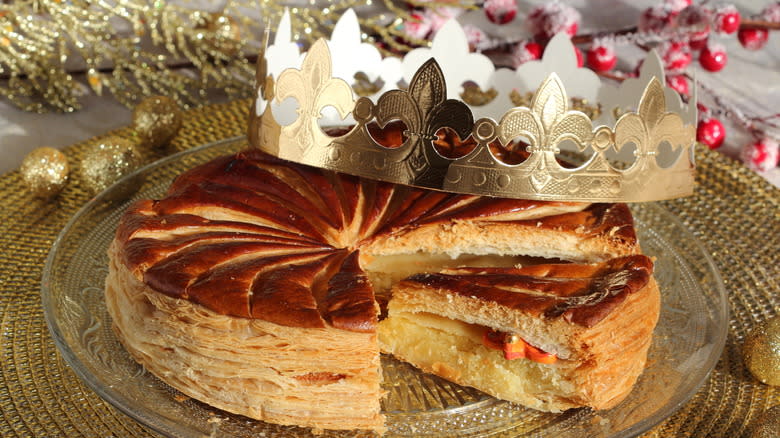
Poland goes all out for Dzień Trzech Króli, or Three Kings Day, on January 6, sometimes even celebrating with parades depicting the three wise men on camel or horseback — complete with real camels and horses. And there's always plenty of Polish three kings cake, ciasto trzech króli, to go around. What kind of ciasto trzech króli you celebrate Dzień Trzech Króli depends where in Poland you are, though, as recipes vary by region and can resemble anything from the spongy Greek vasilopita to the fruitcake-esque Polish bolo-rei. There's one thing Polish king cakes have in common, though: An almond or a coin is typically baked inside, and whoever finds it not only becomes king or queen for the day, but also has extra good luck bestowed upon them for the rest of the year. And as an added bonus, when a ciasto trzech króli is topped with a crown, the lucky person who finds the almond gets to wear it.
Poland is home to another sweet treat that's traditionally served during the season between Christmas and Lent, when Americans typically enjoy king cake: pączki. Pączki is a jelly-filled doughnut that is quite popular with Polish communities in the United States, particularly in Chicago. In Poland, Pączki Day is celebrated the Thursday before Ash Wednesday, also known as Fat Thursday, or Tłusty Czwartek in Polish. Pączki is also enjoyed by Polish-American communities on Dyngus Day, which is the Monday after Easter, to mark the end of the Lenten season and the restrictions that often come with it.
Dreikönigskuchen
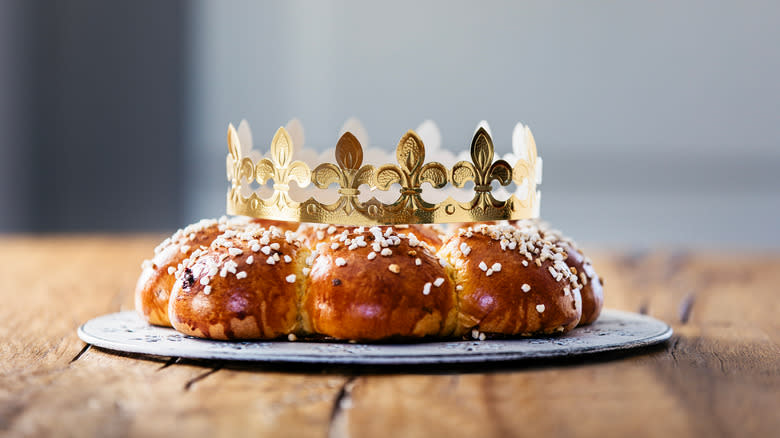
German for "epiphany cake," dreikönigskuchen is enjoyed across Germany and German-speaking parts of Switzerland during the Christmas season and leading up to the Epiphany on January 6. Dreikönigskuchen's simple yet delectable dough includes hints of lemon and vanilla with rum-soaked raisins or chocolate chips kneaded in before baking and is brushed with egg yolks, almond flakes, and granulated sugar when it comes out of the oven. Unlike the circular or ring shapes commonly associated with king cakes, the dough for dreikönigskuchen is formed into nine balls, which are then arranged with one larger dough ball in the middle and eight smaller dough balls placed around it to form the shape of a crown. Like many of its counterparts around the world, an almond or bean is baked into one of the dough balls that makes up a dreikönigskuchen, and whoever finds it in their piece is royalty for the day.
Switzerland has bread researcher Max Währen to thank for its epiphany cake. The tradition of epiphany cakes had all but been forgotten until Währen revived it in 1952 with the Association of Master Bakers and Confectioners. Since then, dreikönigskuchen consistently continued to rise in popularity, and today it's enjoyed by thousands of diners in the region during the holiday season.
Galette Des Rois And Gâteau Des Rois
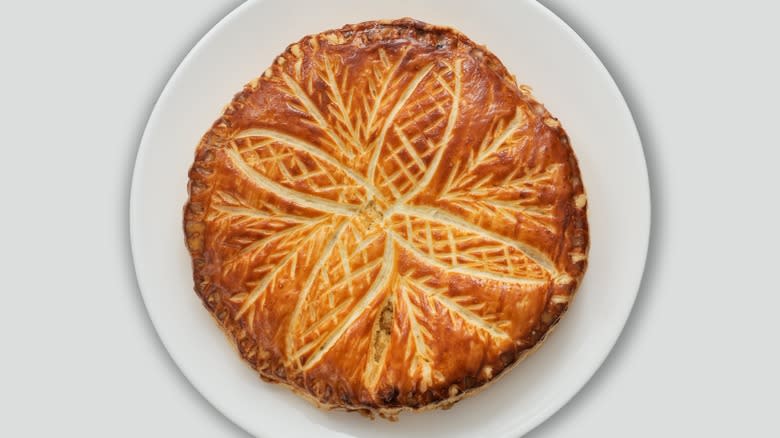
Did you know that in the 16th century, there was a veritable turf war over king cake in France? That's right: Pastry bakers from northern France and bread bakers from the South of France sought to have their take on the Twelfth Night (after Christmas) cake be the standard. Attempts to settle the dispute were futile, which is why France still has not one, but two traditional king cakes today.
The galette des rois of northern France is made from creamy almond frangipane enrobed in buttery, flaky puff pastry, scored with an intricate decoration of your choosing, and brushed with egg wash for a gorgeous golden glaze. Meanwhile, southern France's ring-shaped, brioche-style gâteau des rois is flavored with cognac or orange blossom and embellished with candied fruit and granulated sugar, similar to a fruitcake. The two cakes do have one thing in common, though: A small ceramic fève, or trinket, baked inside.
A fève, which means "bean" in French, has been a mainstay in both galette des rois and gâteau des rois for hundreds of years. What once was traditionally a crown or king can now be just about anything: an animal from a nativity scene, a popular athlete, a pop culture icon — the list goes on and on. When enjoying a French king cake, do remain vigilant: No one wants to chip a tooth on — or worse, swallow! — the coveted fève.
King Cake
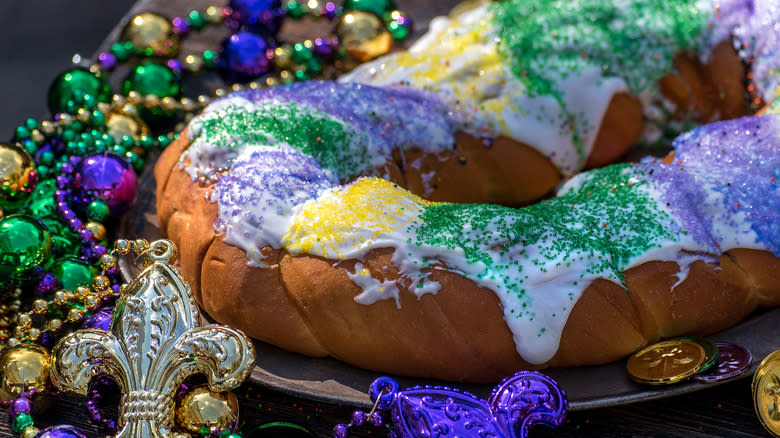
Although king cake was first introduced to New Orlenians in 1870, it wasn't the fixture during Mardi Gras, or Carnival, season in New Orleans that it is today until the early 1980s. With New Orleans bakeries producing more than 750,000 king cakes a year, it's safe to say this tradition is here to stay, as is the small plastic baby found in a king cake. Tradition dictates that whoever finds the baby brings the next king cake to school, work, or parties, which might just be a factor in those impressive annual sales.
Because king cake is more of a bread than a cake, it gets its signature sweetness from the icing on top and the filling within. Popular king cake fillings include cream cheese, pecan praline, cinnamon, and fruits like apple, blueberry, cherry, raspberry, and strawberry. King cake icing is a classic yet irresistible combination of powdered sugar, milk, and vanilla extract. Once the dough has been braided, baked, and iced, it's coated with purple, green, and gold sanding sugar — the purple representing justice, green symbolizing growth, and gold signifying wealth.
Rosca De Reyes
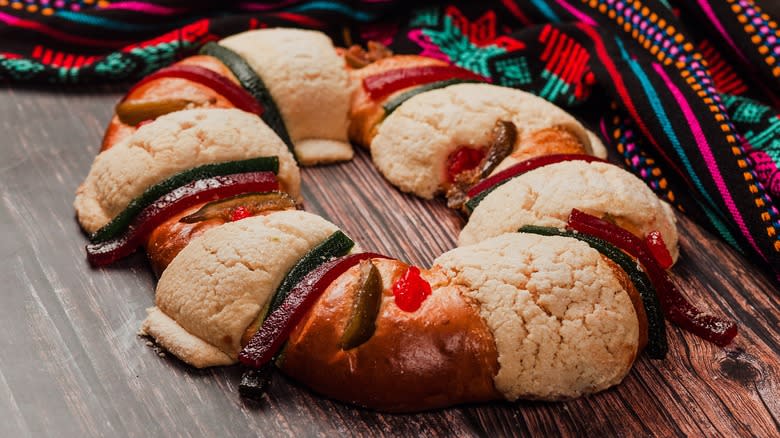
While many of the king cakes around the world are enjoyed throughout the holiday season or into the new year, Mexico's rosca de reyes — or "Wreath of the Kings" — is served only on the Epiphany on January 6 to mark the end of the 12 days of Christmas. This sweet yeast bread gets its flavor from orange blossom water or rum. Shaped to resemble a crown, rosca de reyes can be filled with chocolate, marzipan, strawberry, or whipped cream and topped with candied fruit like cherries, figs, oranges, and quince, a pome fruit that's popular in paste form in Mediterranean countries like Spain.
Like other king cakes, a plastic baby is hidden in rosca de reyes to represent Mary and Joseph hiding their baby from persecution. Somewhat similar to king cake traditions in Louisiana, whoever's slice of rosca de reyes the baby is hiding in on the Epiphany becomes the host of a tamale party on Día de la Candelaria on February 2. Although suddenly being tasked with hosting a party might seem like bad luck, finding the baby is also said to bring good luck, as is the case in other king cake customs.
Tortell De Reis
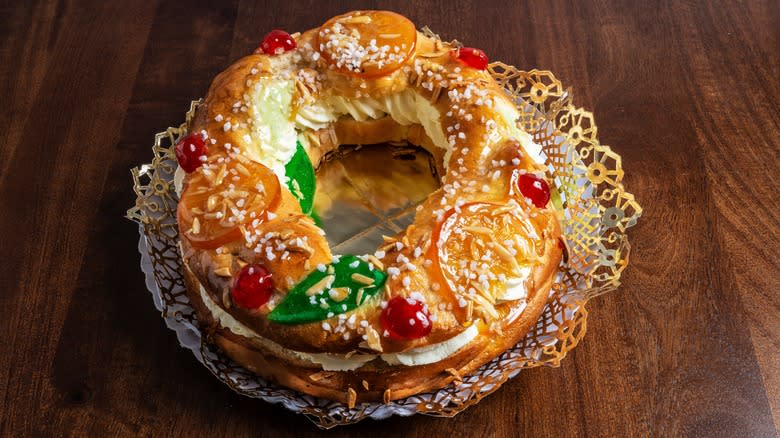
Spain's tortell de reis is a close cousin to Mexico's rosca de reyes, both of which celebrate Dia de los Reyes, also known as Kings Day or the Epiphany, on January 6. Both bread-like cakes are topped with fruit and baked into a circular shape to resemble a crown; however, tortell de reis is usually circular, while rosca de reyes is often more of an oval shape. Besides the inclusion of marzipan in tortell de reis and not in rosca de reyes, there's one other key difference between the two: Rosca de reyes typically has one surprise baked inside, but tortell de reis has two.
Tortell de reis traditionally contains both a bean and a king. Find the king, and you're king for the day, complete with a cardboard or paper crown to prove it. Find the bean, however, and you're footing the bill for the cake. The partygoer whose slice contains the bean is oftentimes excused from paying, though, especially when it's found by a child.
Vasilopita
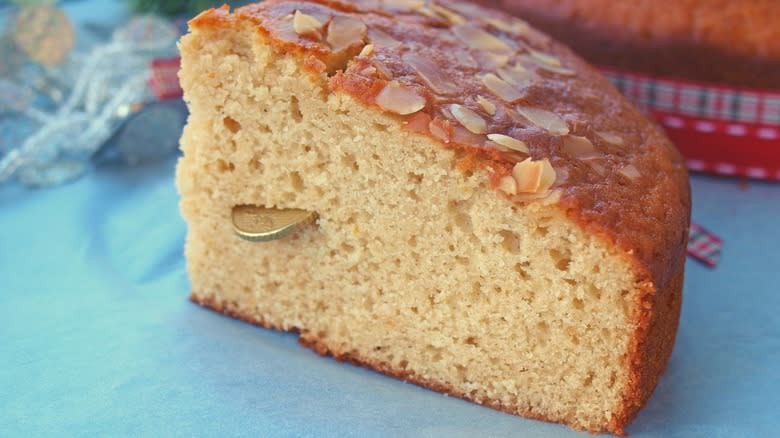
Cyprus and Greece's vasilopita — whose admirers include longtime Great British Baking Show judge Paul Hollywood — is the only king cake on our list with several variations. First, there's the true cake version, flavored with almond, orange, and vanilla and topped with powdered sugar. The sweet, braided bread variety, known as vasilopita tsoureki, also gets its flavor from vanilla and orange, but it incorporates a bit of spice with mastic, a relative of pistachio found on the Greek island of Chios, and mahleb, which is derived from the St. Lucie cherry and closely resembles ground almond.
Like its northern neighbors in Bulgaria, Greece also has a savory take on its vasilopita. In the Thessaly region of Greece, it's common to bake cinnamon-flavored chicken, onions, and tomatoes into vasilopita. Similarly, leeks with ground meat or smoked sausage can be found in Macedonian vasilopita. Better yet, some vasilopita even marry the savory with the sweet by baking Romano cheese into sweet bread. No matter the variety, vasilopita commonly has a coin baked inside, which brings not only good luck, but also a prize.
Another thing Greek vasilopita has in common with Bulgarian banitsa is when it's served: New Year's Eve. Often decorated with the numerals of the new year, slices are traditionally cut for two honorary guests, Jesus and the Virgin Mary. Then, a third slice is cut for the house itself. After that, slices are served first to the head of the household, then served up by age. Slices often are reserved for family members not present at the celebration, as well as pets.
Read the original article on Tasting Table.

